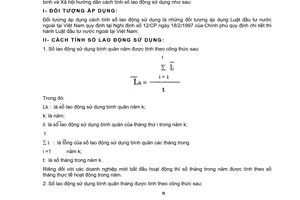Nội dung toàn văn Circular No. 04/2000/TT-BLDTBXH of May 16, 2000, guiding the method of calculating the number of employed laborers according to the provisions of article 54, decree no. 12/CP of February 18, 1997 of The Government
|
THE
MINISTRY OF LABOR, WAR INVALIDS AND SOCIAL AFFAIRS |
OF VIET
|
|
No: 04/2000/TT-BLDTBXH |
, May 16, 2000 |
CIRCULAR
GUIDING THE METHOD OF CALCULATING THE NUMBER OF EMPLOYED LABORERS ACCORDING TO THE PROVISIONS OF ARTICLE 54, DECREE No. 12/CP OF FEBRUARY 18, 1997 OF THE GOVERNMENT
In furtherance of Decree No. 12/CP of February 18, 1997 of the Government detailing the implementation of the Law on Foreign Investment in Vietnam, after consulting a number of concerned ministries and branches, the Ministry of Labor, War Invalids and Social Affairs guides the calculation of the number of employed laborers as follows:
I. OBJECTS OF APPLICATION
Subject to the application of the method of calculating the number of employed laborers are those subject to the Law on Foreign Investment in Vietnam as stipulated in Decree No. 12/CP of February 18, 1997 of the Government detailing the implementation of the Law on Foreign Investment in Vietnam.
II. METHOD OF CALCULATING THE NUMBER OF EMPLOYED LABOR
The annual average number of employed laborers shall be calculated according to the following formula:
|
t |
|||
|
∑ |
li |
||
|
Lk |
= |
i=1 |
|
|
t |
Lk: The average number of employed laborers in year k;
< p="">< p="">< span=""> The total of average
numbers employed
i = 1 laborers of months in year k;
< p="">Especially for enterprises that have started their operation, the number of months in the year shall be calculated according to the actual number of months of operation in the year.
2. The average number of employed laborers per month shall be calculated according to the following formula:
|
n |
In which:
< p="">Xj: The number of laborers of day j in the month, including both contractual and non-contractual laborers who are actually at work and are absent due to: sickness, maternity leaves, female laborers� leaves due to their children�s sickness, labor accidents, annual leaves, being sent to study by the units, paid personal leaves according to the workday-marking table of the units, including managers and cadres of mass organizations. For non-working days, the number of laborers on workday-marking table of the preceeding working day shall be used.
Xj: The total of number of laborers of days in the month
< p="">3. Calculation method for fraction: When calculating the annual average number of employed laborers according to the above-mentioned formula, the fraction (if any) shall be calculated in round figures on the following principles: the fraction of above 0.5 shall be rounded up to 1, those of under 0.5 shall not be included (For example, 499.51 shall be rounded up to 500; 499.45 rounded down to 499). For the monthly average number of employed laborers which has a fraction, two numerals behind the comma shall be kept intact and not rounded.
III. IMPLEMENTATION ORGANIZATION
1. Quarterly, the concerned units shall have to report on the number of employed laborers to the provincial/municipal Labor, War Invalids and Social Affair Services in their respective localities.
2. This Circular takes effect after the date of its signing. The units that have not yet calculated the number of laborers employed in the year 1999 shall apply this calculation method.
In the course of implementation, any arising problems should be reported to the Ministry of Labor, War Invalids and Social Affair for consideration and settlement.
|
|
MINISTER
OF LABOR, WAR INVALIDS AND SOCIAL AFFAIR |

